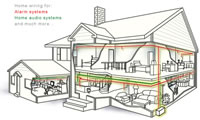Structured Cabling
Structured Cabling
A structured cabling system is a complete system of cabling and associated hardware, which provides a comprehensive telecommunications infrastructure. This infrastructure serves a wide range of uses, such as to provide telephone service or transmit data through a computer network. It should not be device dependent.

We further define a structured cabling system in terms of ownership. The structured cabling system begins at the point where the service provider (SP) terminates. This point is the point of demarcation (demarc) or Network Interface Device (NID).For example, in a telephone system installation, the SP furnishes one or more service lines (per customer requirements). The SP connects the service lines at the point of demarcation. Every structured cabling system is unique. This is due to variations in:
- The architectural structure of the building, which houses the cabling installation;
- The cable and connection products;
- The function of the cabling installation;
- The types of equipment the cabling installation will support — present and future;
- The configuration of an already installed system (upgrades and retrofits);
- Customer requirements; and
- Manufacturer warranties. The methods we use to complete and maintain cabling installations are relatively standard. The standardization of these installations is necessary because of the need to ensure acceptable system performance from increasingly complex arrangements. These help to ensure a proper cabling installation. The benefits of these standards include:
To guarantee optimal system performance, it is crucial to prioritize consistent design and installation practices. Furthermore, adherence to physical and transmission line requirements is non-negotiable. A well-defined framework should be in place to evaluate proposed system expansions and modifications. Finally, maintaining uniform documentation ensures clarity and facilitates efficient management.

